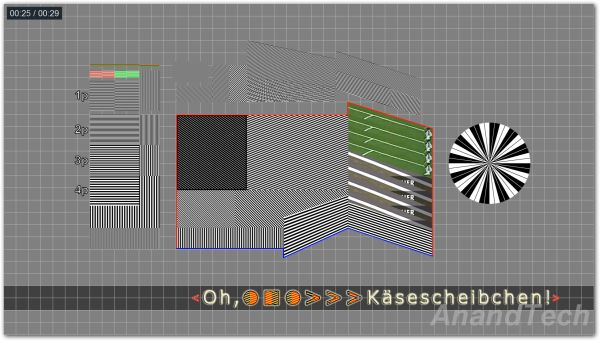Discrete HTPC GPU Shootout
by Ganesh T S on June 12, 2011 10:30 PM EST
Mismatches in the display refresh rate and source frame rate are difficult to spot for the average HTPC user, particularly if the dropped or repeated frames are far apart. Bad deinterlacing performance, on the other hand, may easily ruin the HTPC experience even for the average user. From DVDs to recorded TV shows and even Blu-ray documentaries, interlaced content is quite common.
We have been using the Cheese Slices test to check up on deinterlacing performance in the past. Instead of just covering the cheese slice alone, we will present a set of four consecutive deinterlaced frames from the video for you to judge.
Before presenting the results, let us take a look at how the ideal deinterlacing output should look like (a screenshot from the progressive version of the Cheese Slices clip around the same timestamp)
Click for Lossless Version
NVIDIA GT 430 Cheese Slices Deinterlacing:
MSI GT 520 Cheese Slices Deinterlacing:
AMD 6450 Cheese Slices Deinterlacing:
MSI 6450 Cheese Slices Deinterlacing:
Sapphire 6570 Cheese Slices Deinterlacing:
The Cheese Slices test is an artificial test clip. To bring some real world perspective to the deinterlacing performance, let us take a look at some screenshots of the 'Ship' clip from the Spears and Munsil High Definition Benchmark Test Disc (hereon referred to as the S&M clip). It is supposed to test the edge adaptive deinterlacing capabilities of the GPU. Note the jaggies in the various ropes in the screenshot. Roll the mouse over the various GPUs in the list below the image to see how each candidate performs.

| MSI GT 520 | MSI 6450 | NVIDIA GT 430 | Sapphire 6570 |
Pay particular attention to the deinterlacing performance of the GT 520. Compared to the other 4 cards in the test, this one emerges as the worst of the lot in the Cheese Slices test as well as the real world video test. When this was brought to NVIDIA's attention, they indicated the lack of shaders on the GF119 as the main reason for this issue. It looks like driver updates are not going to solve the issue in the future either. This is a big letdown for the prospective customers of the GT 520. Even though the deinterlacing performance of the GT 430 looks pretty good, a closer look reveals that it is not as effective as AMD's vector adaptive deinterlacing strategy.
On the AMD side, it looks like the reduced core clock frequency and lessened DRAM bandwidth of the MSI 6450 doesn't affect the deinterlacing performance in the Cheese Slices test. Vector adaptive deinterlacing works across all the cards in the 6xxx lineup. However, AMD has admitted to some driver issues for local file playback in the DDR3 based 6450s. This is probably the reason for the bad performance of the MSI 6450 in the S&M ship clip above. In an informal blind test, a majority seemed to prefer the 6570's output in the clip above, but you can decide for yourself.
The Catalyst Control Center allows users to experiment with different deinterlacing algorithms, while NVIDIA's Control Center doesn't. Admittedly, this choice of deinterlacing algorithms is of academic interest only. That said, the bad deinterlacing performance of the GT 520 and the fact that it is not going to improve in the future forces us to declare AMD the winner in this area.































70 Comments
View All Comments
qwertymac93 - Monday, June 13, 2011 - link
What the heck are you talking about?velis - Monday, June 13, 2011 - link
A great review. Provides all the answers one could wish for and even gives some further hints.I sure hope you have something like this lined up for llano.
If I may suggest a couple or three things:
Perhaps you should also mention reclock - it will solve most 23.976 and similar problems... It's not like many will detect that the video is running 1/24000th faster. Plus it's insanely easy to use.
I understand you couldn't just post full blown images for space problems, but those thumbnails require too much work too. Is it possible to display a popup of sorts when one mouse-overs those thumbnails?
Also a vertical line showing 60FPS in those DXVA tests would be great :)
ganeshts - Tuesday, June 14, 2011 - link
I will pass on your request(s) to the person in charge of the graphing engine :)Salfalot - Monday, June 13, 2011 - link
What might have been a nice option is to see what sound levels the cards produced. Even it was only for the GT430 and the HD6570. I know that the decibels can differ between manufacturers but it would have been nice!For the rest a very nice detailed review between HTPC cards. I was deciding which card to buy so this helped a great deal! I was only looking between the HD6450 and the HD6570 but the GT430 is a better option than the HD6450.
nevcairiel - Monday, June 13, 2011 - link
HDMI Audio is purely digital, there is no diference based on what card you use.It depends on the audio decoder, and your receiver at the other end of the HDMI link, the HDMI sound card on those cards does not change the audio.
Salfalot - Monday, June 13, 2011 - link
I think I did not use the right word, as I meant the levels of decibel the fan of the cards produce and not the audio too and through speakers.All reviewed cards have a fan on them and since most of the HTPC setups are in the living room it would have been nice to know which of the cards are most silent.
ganeshts - Monday, June 13, 2011 - link
Though we considered cards with fans in this review, we made it a point to note that the same configuration (GPU model + DRAM bus width + operating frequencies) can be obtained with passive cooling from other vendors.For example, the 6570 has a passively cooled model from HIS with the same config and Zotac has a passively cooled 430 too. Other vendors have also demonstrated passively cooled models in Computex.
cjs150 - Monday, June 13, 2011 - link
Firstly, a truly informative article. Very high quality.The fact that none of AMD, Intel and Nvidia can lock onto to the correct frame rates is unforgiveable. It is not as though these frame rates have changed over the last 6 months. It should not be necessary to be an advanced HTPC user and delve into custom creation of frame rates.
I really hope that the representatives of AMD, Intel and NVidia are hanging their heads in shame at such basic errors - sadly I doubt they care.
Grasso789 - Monday, January 28, 2013 - link
The mistake is rather with Microsoft. Video playback speed should be adapted to the refresh rate of the grafx card. There is a software called Reclock doing that. Then, for example 23,996 Hz can be run with a monitor refresh rate of n times 24 Hz. (The same with audio, because bit-perfect transmission only works with synchronization.) In the end and for most sources, the RAMDAC needed only (multiples of) 24, 25 and 30 Hz. In any system, one of its parts should be the clock master, while the other parts serve.casteve - Monday, June 13, 2011 - link
Excellent review, Ganesh! Your HTPC insight/reviews have been missed.